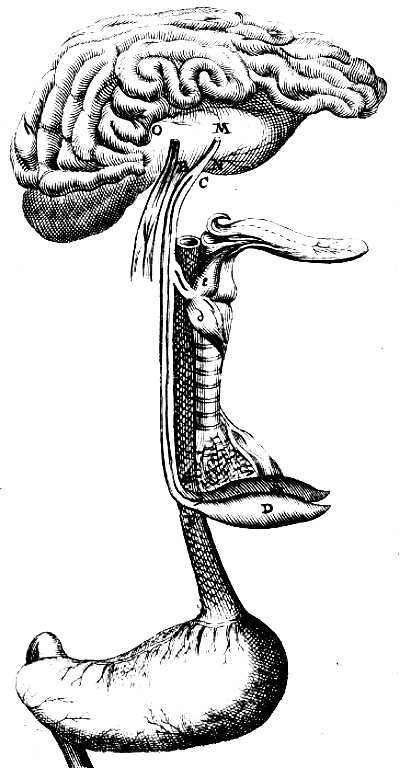How Does the Body Breathe and Swallow Food?
Table of Contents
11. The muscle for breathing D raises its chest, or lowers its diaphragm.
The muscle E is its opposite.

The pore or small channel marked n naturally remains always open.
The animal spirits which are in the concavity of its brain marked m, flows through that pore towards pipe BF which lowers the small skin F.
There they cause those of the muscle E to come to swell the muscle d.
There are certain skins around this muscle d which press it more and more as it swells.
Before all the spirits of the muscle d have passed towards it, they stop their course and make them flow through the tube BF, so that those of the canal n are turned away from it.
This makes them go to the tube cg, which they open at the same time. This causes:
- the muscle
Eto swell - the muscle
dto swell down.
This they continue to do as long as the impetuosity lasts, from which the spirits contained in muscle d, pressed by the skins which surround it, tend to emerge.
Then, when this impetuosity has no more force, they resume their course through tube B F, and thus do not cease to make these two muscles swell and deflate alternately.
What you must also judge of the other muscles which serve the same purpose.
They are all so arranged, that, when it is the sembla bles to d which swell, the space which contains the lungs widens, which is the cause of the air entering from in, just as in a bellows which is opened; and that, when it is their opposites, this space narrows, which is the cause of the air coming out.
12. How does the body swallow the meats which are at the bottom of its mouth?
Muscle D:
- raises the root of its tongue
- holds open the passage by which the air which it breathes must enter its lung
Muscle L:
- closes this passage
- opens that which connects the mouth to the stomach
- raises:
- the point of her tongue which pushes them there
- the animal spirits which come from the concavity of her brain
m, by the pore or small channeln, which remains naturally.
This muscle always remains so swollen while there is no meat at the bottom of the mouth that can press it/
But when there is some meat, its spirits immediately flow through the BF pipe.
- This causes those that come through the channel
nto enter through theCGpipe into the muscleE, where they also go to the muscleD.
This makes the throat open and the food descend into the stomach.
Then afterwards, the spirits of the channel n resume their course through BF as before.
This is also how the body can sneeze, yawn, cough, and make the movements necessary to throw various other excrements.